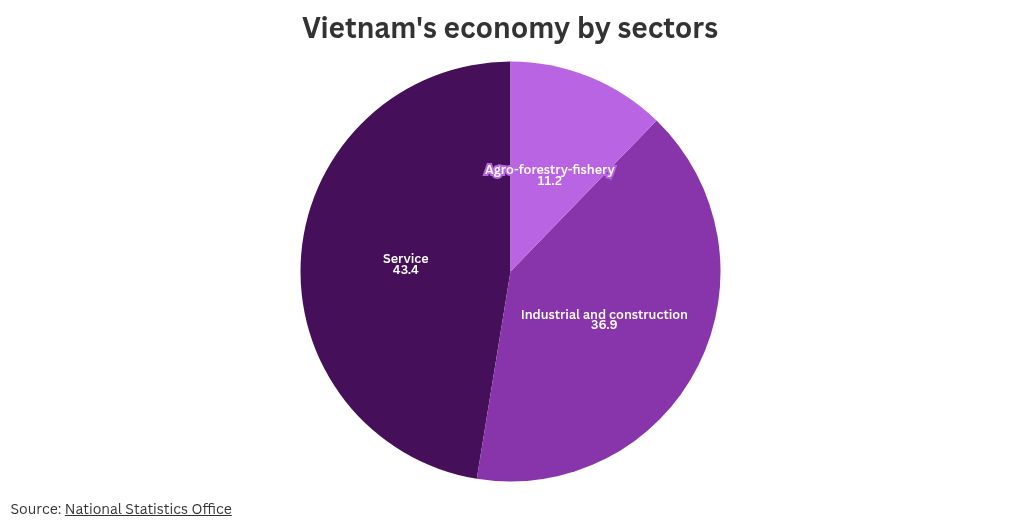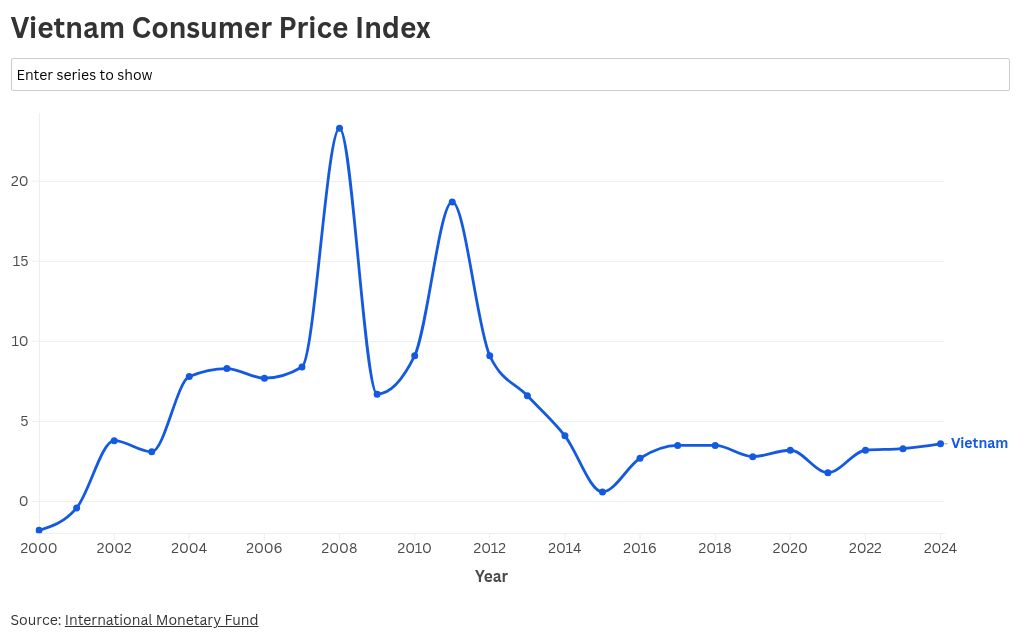Vietnam’s economy posted 7.52 percent growth in the first half of 2025, driven by services and manufacturing, despite global trade tensions and US tariffs. This article provides a detailed examination of inflation, trade, FDI, and business formation trends.
In the first half of 2025, Vietnam’s economy grew by 7.52 percent, building on the strong momentum of 2024 when it posted a GDP growth of 7.09 percent.
Despite persistent global tariff uncertainties and subdued external demand, the country maintained macroeconomic stability and its position as one of Southeast Asia’s fastest-growing economies.
A 15-year first-half high: Vietnam’s GDP surges in H1 2025
Vietnam’s economy grew 7.52 percent in the first six months of 2025, its fastest first-half pace in 15 years. This performance comes at a time when many economies are still grappling with the fallout of high global interest rates, weak consumer demand, and trade disruptions.
The key sectors recorded positive growth within this period, including:
FIND BUSINESS SUPPORT
- Agriculture, forestry, and fisheries continued to provide a strong foundation, expanding by 3.84 percent, supported by domestic stability and export demand;
- Industrial production and construction registered a combined growth of 8.33 percent; and
- Services saw a rebound, growing 8.14 percent over the same period, the highest service-sector growth recorded in any first half since 2020.
Notably, services now represent 43.4 percent of GDP, with industrial production and construction making up 36.9 percent, and agriculture and fisheries accounting for 11.2 percent. Taxes constitute the remaining 8.3 percent. Services also contributed the most to the GDP increase, adding over half of the total growth, followed by industrial and construction activities, and agriculture.
Inflation experienced an uptick, but remains under control
Vietnam’s consumer prices rose in the first quarter of 2025, with the Consumer Price Index (CPI) up 3.22 percent year-on-year, according to the General Statistics Office (GSO). Core inflation, which excludes items like food and energy, came in slightly lower at 3.01 percent.
GSO officials attributed the increase to fluctuations in global commodity markets and ongoing geopolitical tensions, including trade restrictions and conflicts, which disrupted supply chains and slowed global growth.
The most notable drivers of Vietnam’s CPI in the first half of 2025 include:
- Food and food services: This category rose by 3.78 percent, contributing over one-third of the CPI rise. Within this group, pork prices jumped by more than 12 percent due to supply shortages and holiday demand. Rice and poultry prices also edged up;
- Housing and utilities: Housing and utilities increased by 5.11 percent, driven by higher prices for construction materials, including cement and steel. Electricity bills went up after an adjustment to retail power rates in late 2024; and
- Healthcare costs: These expenses saw one of the steepest rises, with pharmaceutical products and medical services up by 14.4 percent, pushing CPI higher by nearly 0.8 percentage points.
Not all sectors moved upward, as several exhibited downward trends, such as:
- Transport costs fell by 2.4 percent, as fuel prices dropped nearly 10 percent and train fares declined;
- Tuition fee waivers in some provinces brought education costs down slightly; and
- Telecom prices also fell marginally.
Core inflation remained below headline inflation as it does not factor in volatile components like food and energy, which were among the main price drivers this quarter.
Trade saw strong gains despite external pressures
Vietnam’s trade performance in the first half of 2025 showed a recovery, with import-export turnover reaching US$432 billion, up 16.1 percent from the same period last year. Exports increased by 14.4 percent, while imports rose 17.9 percent, leading to a trade surplus of US$7.63 billion.
FIND BUSINESS SUPPORT

In terms of goods, computers, electronics, and parts remained the top export category, contributing US$38.41 billion. Telephones and components followed at US$22.4 billion, with machinery, textile products, footwear, and wood-based goods rounding out the top exports.
On the other hand, Vietnam’s imports were led by the same electronics and computer parts at US$56.19 billion, with machinery, textile fabrics, plastics, and metals also seeing high inbound volumes.
|
Top Preliminary Exports in 2025 |
|
|
Goods |
Value (US$ billion) |
|
Computers, electronic products and parts |
38.41 |
|
Telephones and their parts |
22.40 |
|
Other Machinery, instruments, accessories |
22.08 |
|
Textile, sewing products |
15.05 |
|
Footwear |
9.76 |
|
Wood and wooden products |
6.80 |
|
Source: National Statistics Office |
|
The agriculture sector also continued to play a central role in trade. Agro-forestry-fisheries exports rose 15.5 percent year-on-year to nearly US$33.84 billion, contributing a US$9.83 billion trade surplus. Agricultural exports, worth US$18.46 billion, grew by nearly 18 percent, while fisheries and forestry products reached US$5.16 billion and US$8.82 billion, respectively.
Items such as coffee, pepper, and cashew nuts benefited from rising global prices, while rubber exports saw value gains despite lower shipment volumes. On the other hand, rice, fruit, and vegetable exports declined in value due to price drops and weaker demand in key markets.
|
Top Preliminary Imports in 2025 |
|
|
Goods |
Value (US$ billion) |
|
Computers, electronic products and parts |
56.19 |
|
Machinery, instruments, accessories |
22.89 |
|
Textile fabrics |
6.32 |
|
Plastic materials |
5.17 |
|
Iron-steel |
4.54 |
|
Other base metals |
4.52 |
|
Source: National Statistics Office |
|
FDI surge signals investor trust
FDI into Vietnam reached US$21.51 billion in the first half of 2025, marking a 32.6 percent year-on-year increase, according to data from the Ministry of Finance. The strong performance was driven by robust capital injections into existing projects and a sharp rise in capital contributions and share purchases.
While newly registered capital declined by 9.6 percent to US$9.3 billion, additional capital for ongoing projects soared 122 percent to US$8.95 billion. Capital contributions and share purchases also surged by 73.6 percent, totaling US$3.28 billion, indicating heightened investor interest in mergers, acquisitions, and strategic partnerships.
FIND BUSINESS SUPPORT

Disbursed FDI reached US$11.72 billion, up 8.1 percent year-on-year and the highest level recorded for a first-half period in five years. This reflects stronger project implementation and improved operational efficiency across key sectors.
Vietnam continues to attract landmark investments, including Sweden’s SYRE with a US$1 billion circular textiles hub, and a US$1.5 billion project by the Trump Organization in Hung Yen. Major expansions such as the Yen So Park US$1.1 billion project and LEGO’s US$1.3 billion factory in Binh Duong underscore investor confidence in Vietnam’s long-term potential as a manufacturing and innovation hub.
Navigating global economic headwinds
Vietnam’s newly signed trade agreement with the United States, in July 2025, introduces both promise and complexity. While the deal grants Vietnam preferential access to select U.S. markets, including large-engine vehicles and duty-free treatment for American imports, it also introduces new tariffs: a 20 percent duty on most Vietnamese goods and a 40 percent tariff on transshipped items from third countries.
Read more: US Tariffs on Vietnamese Exports: Analyzing the New Framework
Global demand has also softened amid rising interest rates and geopolitical tensions. This was reflected in Vietnam’s April PMI, which fell to 45.6, indicating contraction in manufacturing activity.
Business cycle
In the first half of 2025, Vietnam registered 91,200 newly established businesses, with a total capital of VND 820.9 trillion (approximately US$31.4 billion) and nearly 591,100 registered workers. This marked year-on-year growth of 11.8 percent in number, 9.9 percent in capital, and 13.9 percent in employment.
But business exits also rose. More than 80,800 firms suspended operations, 34,000 halted business pending dissolution, and 12,300 were fully dissolved, resulting in a monthly average of 21,200 market exits.
To turn the tide, the government is focusing on three strategic pillars: institutional reforms, infrastructure development, and workforce upskilling. The accelerated disbursement of public investment, especially in national-scale projects such as the Long Thanh International Airport and the North–South high-speed railway, is expected to stimulate economic activity and boost investor sentiment.
Outlook
A complex interplay of external shocks and internal shifts has shaped Vietnam’s economic trajectory in the first half of 2025. Rising trade tensions, particularly with the US, and a turbulent global environment have weighed on exports and industrial output. Yet, the country has managed to maintain a steady GDP growth pace, moderate inflation, and a rising number of business registrations.
With global demand still fragile and geopolitical uncertainties lingering, Vietnam’s near-term focus will likely remain on boosting domestic consumption, fast-tracking public investment, and supporting enterprise resilience.
Read more: Update Your Company Address After Vietnam’s Provincial Merger: A Brief Guide
(US$1 = VND 26,139)


